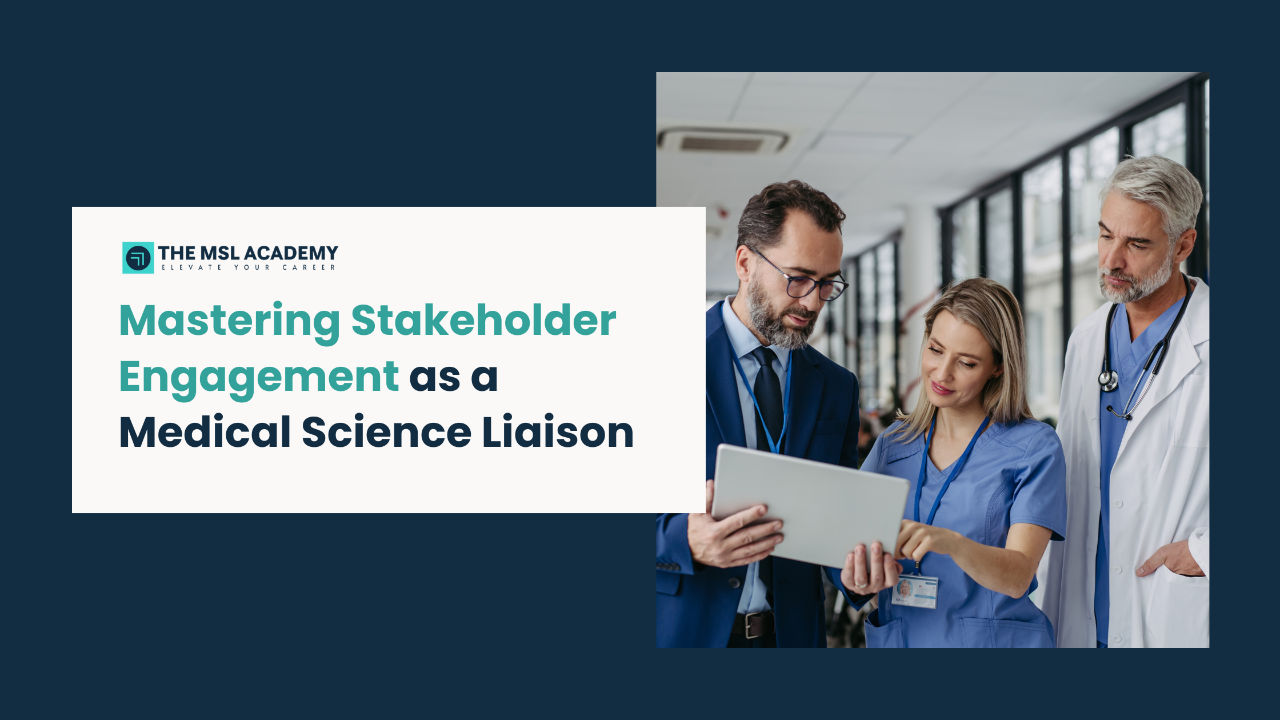Mastering Stakeholder Engagement as a Medical Science Liaison
Jan 31, 2025
Stakeholder engagement is the cornerstone of a successful Medical Science Liaison (MSL) career. As an MSL, you’re not only a scientific expert but also a strategic communicator responsible for building meaningful relationships with Key Opinion Leaders (KOLs), healthcare professionals (HCPs), and internal teams. These relationships don’t just happen—they require intentionality, preparation, and a deep understanding of stakeholder needs.
In this blog, we’ll explore the multifaceted nature of stakeholder engagement, the challenges MSLs encounter, and actionable strategies to cultivate lasting and impactful connections.
What Does Stakeholder Engagement Mean for MSLs?
Stakeholder engagement in the MSL context involves fostering relationships with individuals who influence or contribute to the healthcare ecosystem. These stakeholders include:
- Key Opinion Leaders (KOLs): Physicians, researchers, or other healthcare professionals recognized for their expertise and influence in a particular therapeutic area.
- Healthcare Professionals (HCPs): Clinicians who rely on MSLs for the latest data and insights to inform patient care.
- Internal Teams: Cross-functional collaborators such as marketing, regulatory, and clinical research teams that benefit from the field intelligence gathered by MSLs.
True engagement goes beyond transactional interactions. It involves creating trust-based partnerships where stakeholders view the MSL as a credible and valuable resource.
Why Stakeholder Engagement Is Vital
- Enhancing Trust and Credibility
Engaged stakeholders are more likely to view you as a trusted advisor, which leads to more productive and meaningful scientific exchanges. - Creating Two-Way Communication
Stakeholder engagement allows MSLs to share scientific insights while gathering valuable feedback from the field that can inform organizational strategies. - Driving Patient-Centric Outcomes
By building strong relationships, MSLs can ensure that stakeholders have the data and support needed to make informed decisions, ultimately improving patient care.
Challenges in Stakeholder Engagement
- Limited Access to Stakeholders
- KOLs and HCPs often have packed schedules, making it difficult to secure meetings or sustain regular contact.
- Virtual engagements may lack the personal touch of face-to-face interactions, adding complexity to relationship-building.
- Navigating Competing Priorities
- Stakeholders have diverse goals that may not always align with your organization’s objectives. Understanding their priorities requires tact and adaptability.
- Maintaining Compliance
- All interactions must align with regulatory guidelines, which can limit the scope of discussions and require careful navigation.
Strategies for Effective Stakeholder Engagement
1. Prepare Thoroughly for Every Interaction
- Research stakeholder backgrounds, recent publications, and clinical interests.
- Use tools like PubMed to review their contributions to research in your therapeutic area.
- Anticipate potential questions or objections based on their interests.
2. Build Personalized Engagement Plans
- Segment stakeholders based on their level of influence, engagement history, and therapeutic focus.
- Develop customized messaging that addresses their specific needs and interests.
3. Focus on Adding Value in Every Interaction
- Share new clinical data or research insights that are directly relevant to their work.
- Provide resources such as peer-reviewed articles or conference materials that align with their clinical focus.
4. Leverage Technology to Stay Organized
- Use Customer Relationship Management (CRM) systems to track interactions, set reminders for follow-ups, and maintain records of stakeholder preferences.
- Explore digital engagement tools that enable real-time sharing of scientific data during virtual meetings.
5. Invest in Long-Term Relationship-Building
- Schedule regular touchpoints, even when you don’t have new data to share, to keep the relationship active.
- Celebrate their professional milestones, such as new publications or conference presentations, to demonstrate genuine interest.
How to Handle Common Engagement Scenarios
Scenario 1: Stakeholder is Unavailable for a Meeting
Instead of repeatedly asking for time, send a concise email summarizing key insights and offering to provide additional information at their convenience.
Scenario 2: Stakeholder Has Conflicting Priorities
Acknowledge their challenges and adapt your approach. For example, if a KOL is focused on real-world evidence, tailor your discussion to address data that aligns with those priorities.
Scenario 3: Virtual Engagement is Required
Ensure virtual meetings are concise and visually engaging. Use high-quality slides, interactive tools, and clear audio to maintain stakeholder attention.
Final Thoughts
Mastering stakeholder engagement is both an art and a science. It requires empathy, adaptability, and a commitment to delivering value at every interaction. As you refine your approach, you’ll not only enhance your impact as an MSL but also contribute to advancing healthcare outcomes.
Ready to sharpen your stakeholder engagement skills? Explore The MSL Academy’s training programs for expert guidance and actionable strategies tailored to help you succeed in this critical aspect of your role.



